Monthly Archives: July 2018
 In most ways, my grand-niece, Zoey Iverson is a typical little girl, who happens to be turning three years old, but in other ways, she certainly is not. Zoey loves to watch crafting videos on YouTube, not a common hobby for most three year olds, but one that is likely less annoying to her parents than some of the cartoons these days. Knowing that Zoey watches You Tube is not really surprising, but her taste in videos really is. It is making me wonder if there is a bit of artist’s blood in her veins. I have great respect for those who can do crafts, and if this little girl is learning how to do these things now, she will be good at it.
In most ways, my grand-niece, Zoey Iverson is a typical little girl, who happens to be turning three years old, but in other ways, she certainly is not. Zoey loves to watch crafting videos on YouTube, not a common hobby for most three year olds, but one that is likely less annoying to her parents than some of the cartoons these days. Knowing that Zoey watches You Tube is not really surprising, but her taste in videos really is. It is making me wonder if there is a bit of artist’s blood in her veins. I have great respect for those who can do crafts, and if this little girl is learning how to do these things now, she will be good at it. 
Zoey also loves camping with her family, and fishing with her daddy. She and her daddy are really buddies, but don’t think that Zoey doesn’t have a girlie side. Zoey loves to dress up as a princess, and she can never get enough bath time. For anyone who loves a nice warm soak, especially with bubbles, Zoey’s love of a bath makes perfect sense. She also loves to play pretend with her toys, and she is learning her animals.
I think her biggest job, and her greatest accomplishment is helping her brother eat and learn new things. Her  brother was born with Down’s Syndrome, and Zoey has taken it upon herself to help him learn as much as she can teach him, because Zoey loves her brother, Lucas very much. He is her hero in many ways, and she is a hero to him too…though she may not realize that. Zoey is a sweet girl with a caring heart and she is a great blessing to her family and all who know her. Zoey is growing up very fast, and in many ways, is already wise beyond her three years. Some kids are like hat, and Zoey, loves to take care of others, especially her big brother. I know that she is going to be a wonder little three year old and a great girl, as she grows up too. Today is Zoey’s 3rd birthday. Happy birthday Zoey!! Have a great day!! We love you!!
brother was born with Down’s Syndrome, and Zoey has taken it upon herself to help him learn as much as she can teach him, because Zoey loves her brother, Lucas very much. He is her hero in many ways, and she is a hero to him too…though she may not realize that. Zoey is a sweet girl with a caring heart and she is a great blessing to her family and all who know her. Zoey is growing up very fast, and in many ways, is already wise beyond her three years. Some kids are like hat, and Zoey, loves to take care of others, especially her big brother. I know that she is going to be a wonder little three year old and a great girl, as she grows up too. Today is Zoey’s 3rd birthday. Happy birthday Zoey!! Have a great day!! We love you!!
 When I was a little girl, my family lived in Superior, Wisconsin. Those were wonderful years, but in more recent years we had not been back to Superior for a number of years. When my mom, Collene Spencer wanted to go back to Superior, my sister, Cheryl Masterson and I took her, since our dad had passed away by then. That, Ancestry, and Facebook opened up a whole new world for Cheryl and me. We got to know our cousins, and the list of cousins we know grows every day…or at least every year. This year, with the Schumacher Family Reunion, we knew we had to go, even though it would be without Mom this time. This trip was bittersweet, because of course, Mom was missing.
When I was a little girl, my family lived in Superior, Wisconsin. Those were wonderful years, but in more recent years we had not been back to Superior for a number of years. When my mom, Collene Spencer wanted to go back to Superior, my sister, Cheryl Masterson and I took her, since our dad had passed away by then. That, Ancestry, and Facebook opened up a whole new world for Cheryl and me. We got to know our cousins, and the list of cousins we know grows every day…or at least every year. This year, with the Schumacher Family Reunion, we knew we had to go, even though it would be without Mom this time. This trip was bittersweet, because of course, Mom was missing.
Nevertheless, we have had a wonderful time. When we were here the last time, our first cousins once removed, Les and Bev Schumacher had wanted us to come to their house, but our time was do limited, that we didn’t have time to. This time, their daughter, Cathy La Porte graciously invited us for dinner this evening. We got to meet her husband, Gary, as well as to see her brother, Brian Schumacher and his wife, Lisa again. It was simply a wonderful evening. Cathy is an excellent cook and we were treated to Walleye Pike and Northern Pike that Cathy’s husband, Gary caught in North Dakota with his brother this past  week. Wow!!! Was it good. Dessert was a Cherry Crumble that Lisa’s friend had given her, and everyone loved it.
week. Wow!!! Was it good. Dessert was a Cherry Crumble that Lisa’s friend had given her, and everyone loved it.
The evening was very enjoyable and will always be a sweet memory from our trip. The trip has gone by so fast, and what we thought was enough time, really wasn’t…it never is, is it? Nevertheless, the friendships (cousinships) formed will last for the rest of our lives, and while our parents weren’t there this time, we know they would be smiling…happy to see their daughters and granddaughter continue to reach out to the family as if they were with us. I guess we are carrying on the connections, and that would make them happy, and it makes me happy.
 My grand-niece, Raelynn Masterson is growing up so fast that I find myself feeling stunned, so I can only imagine how her parents feel. She will be starting high school this year, and she is hoping to get into drivers education and computer art. The drivers education class makes sense, because what 15 year old doesn’t want to learn to drive, but the computer art class surprised me a little, because I didn’t realize that she was the artsy type, although I should have, because when I think about it, her nature is to be more quiet…a gentle soul. She is beginning to really think about higher education and considering options beyond art. Her mom thinks she would make an amazing vet. She does so well with any animal she comes into contact with. Her mom thinks it is her quiet demeanor that makes the animals love her. I know that her grandma, Cheryl Masterson’s dog and cat loves Raelynn, so being a vet could be a really good option.
My grand-niece, Raelynn Masterson is growing up so fast that I find myself feeling stunned, so I can only imagine how her parents feel. She will be starting high school this year, and she is hoping to get into drivers education and computer art. The drivers education class makes sense, because what 15 year old doesn’t want to learn to drive, but the computer art class surprised me a little, because I didn’t realize that she was the artsy type, although I should have, because when I think about it, her nature is to be more quiet…a gentle soul. She is beginning to really think about higher education and considering options beyond art. Her mom thinks she would make an amazing vet. She does so well with any animal she comes into contact with. Her mom thinks it is her quiet demeanor that makes the animals love her. I know that her grandma, Cheryl Masterson’s dog and cat loves Raelynn, so being a vet could be a really good option. 
Raelynn is hoping to be able to find a job soon, because what girl doesn’t need spending money, but Raelynn really isn’t a fussy, prissy type, but she is a beautiful girl. Raelynn has always been a fairly quiet, happy girl, with a quirky side. She loves everyone in her life and always has a big smile and a hug for all of them.
A year ago, Raelynn has surgery to correct scoliosis. It is amazing that it has been a year already. To this day it is hard for her parents to let her get back to her normal activities. After a major surgery, it can be nerve wracking to let go. Her mom told me that she has issues letting her do things that may jar her back. They went to  Thermopolis this year and she wanted to go down the sides and jump off the high dive. Mom was completely against it, so Dad called her surgeon and he said that she would be fine. Mom lost on that one, and she did go down the high dive. Raelynn was a little unsure of it, and it took her going up and coming down once but she jumped off and she was fine. Her parents told me that they were so proud of her. She was facing a legitimately fear of heights, but she did it. When the fair came, they found that it was a little easier to let her ride the things she wanted to ride, and be a kid. She faces her fears and goes forward. It is a show of bravery and courage. Her strength of character is well in tact and her faith in God unbelievable. Today is Raelynn’s 15th birthday. Happy birthday Raelynn!! Have a great day!! We love you!!
Thermopolis this year and she wanted to go down the sides and jump off the high dive. Mom was completely against it, so Dad called her surgeon and he said that she would be fine. Mom lost on that one, and she did go down the high dive. Raelynn was a little unsure of it, and it took her going up and coming down once but she jumped off and she was fine. Her parents told me that they were so proud of her. She was facing a legitimately fear of heights, but she did it. When the fair came, they found that it was a little easier to let her ride the things she wanted to ride, and be a kid. She faces her fears and goes forward. It is a show of bravery and courage. Her strength of character is well in tact and her faith in God unbelievable. Today is Raelynn’s 15th birthday. Happy birthday Raelynn!! Have a great day!! We love you!!
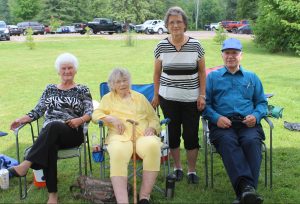
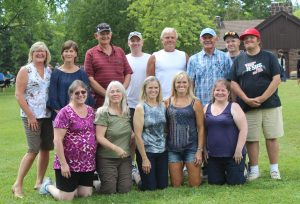 A few years back, I connected with a member of my Schumacher cousins, Tracey Schumacher Inglimo, in what would become a quest to get to know all of my Schumacher cousins, and like my Byer cousins, there were lots of them. The journey has been a wonderful trip, as my sisters and I have cultivated friendships with these precious cousins, some of whom we met on our 2014 trip back to our roots in Superior, Wisconsin. Now, four years later, my sister, Cheryl Masterson; her daughter, Liz Masterson; and I have returned to Superior, Wisconsin for a family reunion. We have been so excited for this reunion to happen, and in fact, have looked forward to reuniting with all of our cousins since we first met or found each other on Ancestry and Facebook.
A few years back, I connected with a member of my Schumacher cousins, Tracey Schumacher Inglimo, in what would become a quest to get to know all of my Schumacher cousins, and like my Byer cousins, there were lots of them. The journey has been a wonderful trip, as my sisters and I have cultivated friendships with these precious cousins, some of whom we met on our 2014 trip back to our roots in Superior, Wisconsin. Now, four years later, my sister, Cheryl Masterson; her daughter, Liz Masterson; and I have returned to Superior, Wisconsin for a family reunion. We have been so excited for this reunion to happen, and in fact, have looked forward to reuniting with all of our cousins since we first met or found each other on Ancestry and Facebook.
The reunion took place today at Pattison Park, and it definitely lived up to every hope we had for it. These precious cousins were friendly, hospitable, and informative, while also being curious about us too. We all shared tons of stories about our families, and of course, pictures of our kids, grandkids, and great grandkids. We hugged on the little ones, most of whom looked at us with a sense of wonder as to who we were, and maybe even wondering if we should be hugging them at all…at least until their parents said it was ok. We moved from group to group, and person to person trying to get to know everyone, all the while knowing that there just wasn’t enough time. We found out who the jokesters were too, because what family would be complete without those wonderful people who keep us laughing. We built bonds that will last a lifetime, and parted ways with expressions of sadness that the time had passed far to quickly. We tried to see how soon we could feasibly do this again, knowing that for most of us Facebook would have to suffice until the next reunion.
The time went by far too quickly indeed, and while we wish we could have had far more time to sit and talk, we all knew in our hearts that we had been given a precious gift…a gift of family, friendship, love, and a sense of belonging, because after all, that is what family reunions are all about. Families grow quickly, and the numbers can quickly grow to a point of losing sight of the ones who started the family in the beginning, but at reunions, 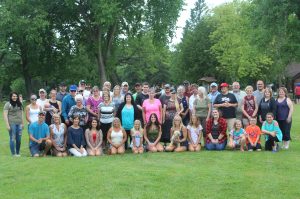
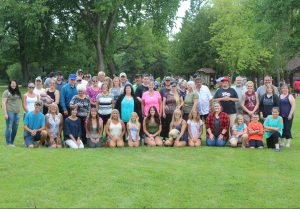 those who have left us are remembered and discussed, because everyone is trying to put into context, just exactly where they fit in with all these people. We talked of those who weren’t with us with love and sadness, because they would have really loved that their families have made the effort to keep the closeness going. To all those who made this reunion so very special, we love you and thank you for making our family reunion amazing.
those who have left us are remembered and discussed, because everyone is trying to put into context, just exactly where they fit in with all these people. We talked of those who weren’t with us with love and sadness, because they would have really loved that their families have made the effort to keep the closeness going. To all those who made this reunion so very special, we love you and thank you for making our family reunion amazing.
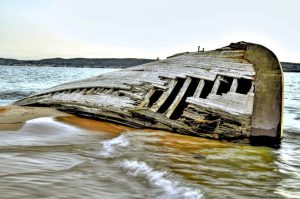 When a lake, or group of lakes, are almost the size of a small sea, with all the storm possibilities that go with a body of water the size of the sea, shipwrecks and other disasters on the water are bound to occur. There is a stretch of land along the Michigan coast, known to many as the Shipwreck Coast or the Graveyard of the Great Lakes. It is an 80 mile stretch between Grand Island and Whitefish Point, and the vicious waters have sunk hundreds of ships. Edmund Fitzgerald, Cyprus, and Vienna are just a few of the vessels lost beneath the waves, where they took their crew to a watery grave…their names forever etched in maritime lore. Their wreckages lie in varying depths of Lake Superior, the largest of the Great Lakes.
When a lake, or group of lakes, are almost the size of a small sea, with all the storm possibilities that go with a body of water the size of the sea, shipwrecks and other disasters on the water are bound to occur. There is a stretch of land along the Michigan coast, known to many as the Shipwreck Coast or the Graveyard of the Great Lakes. It is an 80 mile stretch between Grand Island and Whitefish Point, and the vicious waters have sunk hundreds of ships. Edmund Fitzgerald, Cyprus, and Vienna are just a few of the vessels lost beneath the waves, where they took their crew to a watery grave…their names forever etched in maritime lore. Their wreckages lie in varying depths of Lake Superior, the largest of the Great Lakes.
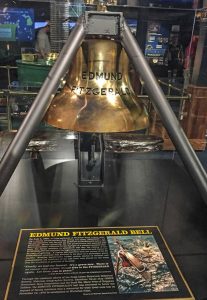 My husband, Bob and I came up for a visit in 1975, and my Uncle Bill Spencer, the original family historian, told us about the shipwrecks of Lake Superior, and how there were many that could be seen pretty clearly when flying over the lake. I wished we could have taken such a flight, and seen those ships for myself. My thoughts drifted to the time of the wrecks, and how the accident happened and about the people who lost their lives there.
My husband, Bob and I came up for a visit in 1975, and my Uncle Bill Spencer, the original family historian, told us about the shipwrecks of Lake Superior, and how there were many that could be seen pretty clearly when flying over the lake. I wished we could have taken such a flight, and seen those ships for myself. My thoughts drifted to the time of the wrecks, and how the accident happened and about the people who lost their lives there.
Lake Superior was known for its big storms, and when the November gales came it was treacherous, especially along the Shipwreck Coast. “This part of Lake Superior is particularly treacherous thanks to a unique combination of geography and storm patterns,” Bruce Lynn, executive director of the Great Lakes Shipwreck Museum in Paradise, Michigan says. “Storms build up over Canada and the Great Plains. Their strong winds blow uninterrupted over 200 miles of open waters, building up enormous waves that drive ships into the coast or break them in half.” Fog, snow squalls, smoke from forest fires, traffic jams on the busy waters and human error add to sailing hazards.
 One massive ore carrier, the Edmund Fitzgerald was the largest to sail Lake Superior, nevertheless, it was a gale or a rogue wave that caused its sinking, but what it was is debated to this day. Gordon Lightfoot immortalized the tragedy in his song “The Wreck of the Edmund Fitzgerald.” The Fitzgerald’s 200 pound bronze bell was salvaged from the bottom of the lake later on, and and restored. The men were never recovered, because as most people know, Lake Superior never gives up her dead. The ship darted out on November 7, 1975, hoping to make Whitefish Point, but that was not to be. I think that just the questions behind the shipwrecks on Lake Superior makes the thousands of shipwrecks a huge mystery.
One massive ore carrier, the Edmund Fitzgerald was the largest to sail Lake Superior, nevertheless, it was a gale or a rogue wave that caused its sinking, but what it was is debated to this day. Gordon Lightfoot immortalized the tragedy in his song “The Wreck of the Edmund Fitzgerald.” The Fitzgerald’s 200 pound bronze bell was salvaged from the bottom of the lake later on, and and restored. The men were never recovered, because as most people know, Lake Superior never gives up her dead. The ship darted out on November 7, 1975, hoping to make Whitefish Point, but that was not to be. I think that just the questions behind the shipwrecks on Lake Superior makes the thousands of shipwrecks a huge mystery.
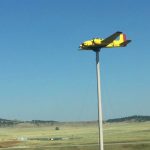 I don’t often find myself traveling along on 1-90 in the Sundance, Wyoming area, but when I did back in 2014, I was surprised to see a very low flying airplane coming toward us, or I thought it was at first. The bright yellow Beachcraft Twin Bonanza was actually perched upon a 70 foot pole beside the road. The owners of the plane, Mick and Jean Quaal lived the antique plane, but the cost to put it back in flying condition was in the neighborhood of $200,000. Still, they hated to see the beautiful relic sitting on the ground just rusting away.
I don’t often find myself traveling along on 1-90 in the Sundance, Wyoming area, but when I did back in 2014, I was surprised to see a very low flying airplane coming toward us, or I thought it was at first. The bright yellow Beachcraft Twin Bonanza was actually perched upon a 70 foot pole beside the road. The owners of the plane, Mick and Jean Quaal lived the antique plane, but the cost to put it back in flying condition was in the neighborhood of $200,000. Still, they hated to see the beautiful relic sitting on the ground just rusting away.
So, they came up with a plan to give the plane another chance to fly. It was a perfect plan. The flame was flying again, and every person who drove down I-90 could see it. The plane is not sitting in a locked position, but rather can turn with the wind, basically making it a very expensive windsock. Raising it in place took the assistance of a flatbed truck, a crane, a manlift and several people guiding the aircraft with ropes, says Jean. “I call it a monument to aviation – and 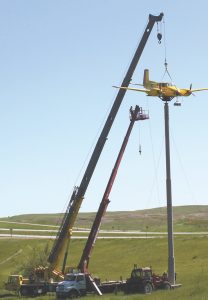 the area’s largest windsock,” she laughs. “The plane turns in the direction of the wind,” adds Mick, “and those who look closely might even see its propellers spinning.”
the area’s largest windsock,” she laughs. “The plane turns in the direction of the wind,” adds Mick, “and those who look closely might even see its propellers spinning.”
It is believed to be a D50E model, but there is not much of a differences between the models. The Twin Bonanza was first flown in 1949 and production began in 1951. The United States Army adopted the Twin Bonanza as the L-23 “Seminole” utility transport, purchasing 216 of the 994 that were built. The pole had to be pretty big, because the wingspan of a Twin Bonanza is 45 feet. The fuselage length is about 31 feet. There is what appears to be a device a pivot under the airplane that allows it to rotate with the wind. And if people look closely, they can see that the propellers rotate freely in the wind. Owned by Mick and Jean Quaal, the plane has a large Q painted on the side. While I had been surprised to see the plane so low to the ground, I thought it was a great idea to let it be flying again.

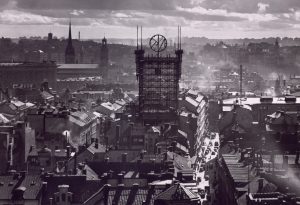 Sometimes, a picture can instill such a strange awareness within us that it is hard to get the picture out of our heads. It doesn’t have to be something horrible, bloody, or shocking, but simply something unusual. The phone tower in Stockholm, Sweden, built in 1887 is that kind of a picture, for sure.
Sometimes, a picture can instill such a strange awareness within us that it is hard to get the picture out of our heads. It doesn’t have to be something horrible, bloody, or shocking, but simply something unusual. The phone tower in Stockholm, Sweden, built in 1887 is that kind of a picture, for sure.
Technology has changed so much over the years, and this tower was a relic of the past. That is probably why the image has stuck in my head all this time. The tower served its purpose at the time, connecting 5,000 telephone wires and providing service to all those people, but to me it seemed rather dangerous in many ways. The telephone was an amazing invention, but somehow, the idea of buried cable never occurred to the inventor or the engineers who made it a reality for everyone. The service was very expensive, and so only for the wealthy…a fact that would change in years to come.
Similar towers sprang up around the world, and most residents soon grew to hate the massive amounts of lines that littered their skyline. Still, it was the only way at the time, and the telephone was, after all, an important invention. Too bad they couldn’t immediately come up with the wireless version we all enjoy these days. The telephone towers were used shortly before telephone companies started burying their wires in about 1913.
The change was well received, since most residents hated it, and some of the work was done after a snowstorm downed telephone poles, causing the cities to pay for the changes. Soon the hated phone lines began to disappear. I can see why the towers are hated, and to this day, most photographers hate to have the towers 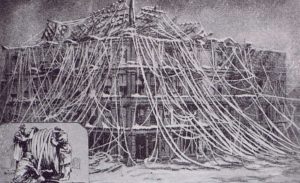
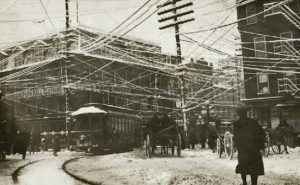 and wires in their photographs. I have often found myself wishing the wires were missing from that perfect shot I got as my husband and I walked along the walking paths in Casper, so I can understand the way the residents of Stockholm, New York, and Boston felt about the monstrosity that was the telephone lines in their cities. Thankfully for the residents, the problem was solved when the tower burned down on July 25, 1953.
and wires in their photographs. I have often found myself wishing the wires were missing from that perfect shot I got as my husband and I walked along the walking paths in Casper, so I can understand the way the residents of Stockholm, New York, and Boston felt about the monstrosity that was the telephone lines in their cities. Thankfully for the residents, the problem was solved when the tower burned down on July 25, 1953.
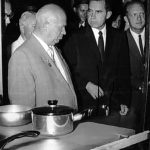 The debate between capitalism and communism is not new, and in fact has been going on for a long time. Possibly one of the strangest debates, known as the “kitchen debate” was between Vice President Nixon and Soviet leader Nikita Khrushchev. The debate was heated at times, but what was strangest about the debate was the fact that it took place in the middle of a model kitchen set up for an exhibit. Why they would have such a discussion in a model kitchen at a national exhibit is the really beyond me, but that is where it took place.
The debate between capitalism and communism is not new, and in fact has been going on for a long time. Possibly one of the strangest debates, known as the “kitchen debate” was between Vice President Nixon and Soviet leader Nikita Khrushchev. The debate was heated at times, but what was strangest about the debate was the fact that it took place in the middle of a model kitchen set up for an exhibit. Why they would have such a discussion in a model kitchen at a national exhibit is the really beyond me, but that is where it took place.
The so-called “kitchen debate” became one of the most famous episodes of the Cold War, and many think it might have really led to fighting words, had it not been for the two men controlling their tempers in the end. The meeting was set up in late 1958. In an effort to draw the two nations closer together, the Soviet Union and the United States agreed to set up national exhibitions in each other’s nation as part of their new emphasis on cultural exchanges. The Soviet exhibition opened in New York City in June 1959, and the United States exhibition opened in Sokolniki Park in Moscow in July. On July 24, before the Moscow exhibit was officially opened to the public, Vice President Nixon served as a host for a visit by Soviet leader Khrushchev. As Nixon led Khrushchev through the American exhibition, the Soviet leader’s famous temper began to flare. When Nixon demonstrated some new American color television sets, Khrushchev launched into an attack on the so-called “Captive Nations Resolution” passed by the United Stares Congress just days before. The resolution condemned the Soviet control of the “captive” peoples of Eastern Europe and asked all Americans to pray for their deliverance. I don’t suppose that resolution set well with Khrushchev, and coming right before the exhibition probably set the whole debate in motion.
After denouncing the resolution, Khrushchev then sneered at the United States technology on display, saying that the Soviet Union would have the same sort of gadgets and appliances within a few years. Nixon, was not a man to back down from a debate, so he cane right back and goaded Khrushchev by stating that the Russian leader should “not be afraid of ideas. After all, you don’t know everything.” The Soviet leader snapped at Nixon, “You don’t know anything about communism–except fear of it.” With a small army of reporters and photographers following them, Nixon and Khrushchev continued their argument in the kitchen of a model home built in the exhibition. With their voices rising and fingers pointing, the two men went at each other. I’m sure it was quite a show. Nixon suggested that Khrushchev’s constant threats of using nuclear missiles could lead to war, and he chided the Soviet for constantly interrupting him while he was speaking. Taking these words as a threat, Khrushchev warned of “very bad consequences.” Perhaps feeling that the exchange had gone too far, the Soviet leader then noted that he simply wanted “peace with all other nations, especially America.” Nixon, 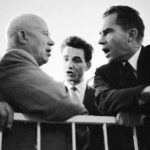 feeling slightly embarrassed said that he had probably not “been a very good host.” The debate, so quickly inflamed, fizzled in much the same way…at least between the two men…not so much the media.
feeling slightly embarrassed said that he had probably not “been a very good host.” The debate, so quickly inflamed, fizzled in much the same way…at least between the two men…not so much the media.
The “kitchen debate” was front-page news in the United States the next day. For a few moments, in the confines of a “modern” kitchen, the diplomatic gloves had come off and America and the Soviet Union had verbally jousted over which system was superior…communism or capitalism. As with so many Cold War battles, however, there was no clear winner…except perhaps for the United States media, which had a field day with the dramatic encounter. It was the sensationalism that the news media craves.
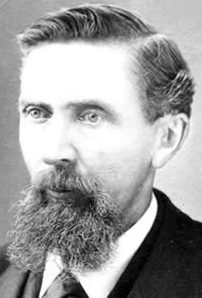 When Conrad Kohrs, immigrated to the United States at the age of 15, he was seeking his fortune like so many other immigrants were. The year was 1850, and while it is odd these days to think of a 15 year old boy immigrating to America alone now, it wasn’t entirely unheard of then. Kohrs was a native of Denmark, and had planned to head west to make his fortune in gold or silver. Unfortunately, while he had some small success in California and British Columbia, try as he might, the “big strike” always eluded Kohrs.
When Conrad Kohrs, immigrated to the United States at the age of 15, he was seeking his fortune like so many other immigrants were. The year was 1850, and while it is odd these days to think of a 15 year old boy immigrating to America alone now, it wasn’t entirely unheard of then. Kohrs was a native of Denmark, and had planned to head west to make his fortune in gold or silver. Unfortunately, while he had some small success in California and British Columbia, try as he might, the “big strike” always eluded Kohrs.
Kohrs tended to follow the crowd, and in 1862, he joined the latest western gold rush and headed for western Montana, where rich gold deposits had been found at Grasshopper Creek. It might be true that gold was plentiful at Grasshopper Creek, but Kohrs realized that he could make more money mining the miners than mining for gold. Miners need lots of supplies, and the man who was able to supply the needs, was the one who made money. He established a butcher shop in the mining town of Bannack and began to prosper.
His work as a butcher led Kohrs into the cattle business. Cattle were a big commodity, being in relatively short supply in frontier Montana. Much has changed today, and Kohrs had a big part in that. Kohrs traveled around the territory to purchase prime animals. He had several brushes with the highwaymen who plagued the isolated roads of Montana. Determined to stop these murderous bandits, Kohrs joined a group of Virginia City vigilantes, and helped track down and hang the outlaws. By 1864, robberies in the territory had plummeted. Proper or not, vigilante justice, got the point across very well.
Whether he was good at being part of a vigilante group or not, it couldn’t be what made his living. Kohrs began shifting the focus of his meat processing business to the supply side. In 1864, he established a large ranch near the town of Deer Lodge, where he fattened his cattle for market. Kohrs was pretty much the only major rancher in the western region of the territory. This caused his business to boom as Montana grew. As always happens, eventually, competition from cattle driven overland into the territory from Texas began to challenge Kohrs’ monopoly. Nevertheless, he continued to prosper, and remained the largest cattle rancher in Montana for several decades. 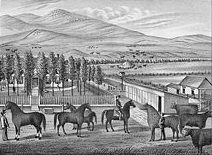
Kohrs entered the political arena in 1885, translating his economic strength into political power. He was elected to the Montana Territorial Legislature. Kohrs and his fellow ranchers had considerable influence over Montana in the years to come, and Kohrs went on to become a state senator in 1902. The big ranchers never had a free hand in Montana, however, because mining interests and farmers always kept the ranchers in check, but it wasn’t for a lack of trying. Kohrs was widely celebrated as one of the greatest pioneers in Montana history. He died on July 23, 1920 at the age of 85 in Helena.
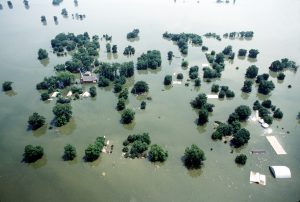 For many years, levee systems were built along rivers to hold back flood waters. They work very well…until they don’t. When a levee ruptures, the resulting flood is usually devastating. From June through August of 1993, the midwestern United States received an unusually large amount of rain…far more than normal. The rain led to severe flooding, particularly along the Illinois and Missouri shores. Then, on July 22, 1993, the levee holding back the flooding Mississippi River at Kaskaskia, Illinois, ruptured. The town’s people were forced to flee on barges. In all, more than 1,000 levees burst in late July, but, the incident at Kaskaskia was the most dramatic event of the flood. The town, which was virtually an island, was protected by a levee that the town attempted to shore up even after the bridge connecting the town to the riverside was wiped out by the rising river. At
For many years, levee systems were built along rivers to hold back flood waters. They work very well…until they don’t. When a levee ruptures, the resulting flood is usually devastating. From June through August of 1993, the midwestern United States received an unusually large amount of rain…far more than normal. The rain led to severe flooding, particularly along the Illinois and Missouri shores. Then, on July 22, 1993, the levee holding back the flooding Mississippi River at Kaskaskia, Illinois, ruptured. The town’s people were forced to flee on barges. In all, more than 1,000 levees burst in late July, but, the incident at Kaskaskia was the most dramatic event of the flood. The town, which was virtually an island, was protected by a levee that the town attempted to shore up even after the bridge connecting the town to the riverside was wiped out by the rising river. At  9:48am, the levee broke, leaving the people of Kaskaskia with no escape route other than two Army Corp of Engineers barges. By 2pm, the entire town was underwater.
9:48am, the levee broke, leaving the people of Kaskaskia with no escape route other than two Army Corp of Engineers barges. By 2pm, the entire town was underwater.
The rupture of the levee at Quincy, Illinois, left no way to cross the Mississippi River for 250 miles north of Saint Louis. In Grafton, Illinois, flood waters reached two stories high. Other towns fared somewhat better, but the flooding was bad everywhere. In Saint Genevieve, Missouri, the entire town turned out in a desperate attempt to raise the levee. Prisoners were even brought in to assist the effort. The river crested at a record 49 feet, just two feet below the improved levee. The flood inundated 1 million acres of prime farm land and wreaked havoc on the area’s economy. Miles of wheat fields were too saturated to harvest that season. In addition, the herbicides from the farms washed down the river and severely damaged fish farms in Louisiana. Many other people lost their jobs when barge traffic on the river was suspended for two months. The Mississippi 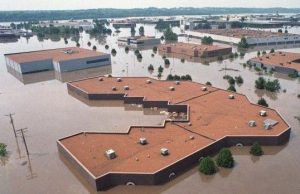 flood of 1993 caused $18 billion in damages and killed 52 people.
flood of 1993 caused $18 billion in damages and killed 52 people.
Levees can save lives, but when levees fail…people die, and property is destroyed. Sometimes, there is some warning, but other times, the flood that was expected, brings with it an unexpected consequence. And I can’t think of a worse unexpected consequence, than having far more water inundate an area that the flood could possibly have brought in. That was the case in 1993, and especially the case in Kaskaskia, Illinois. No one was prepared for the massive amount of water, and for 52 people, there was no way of escape.

